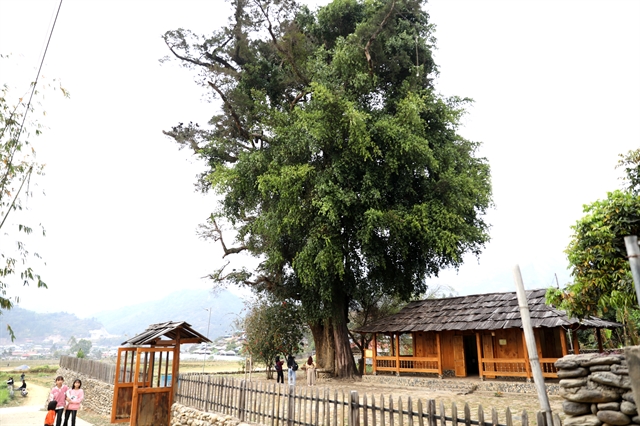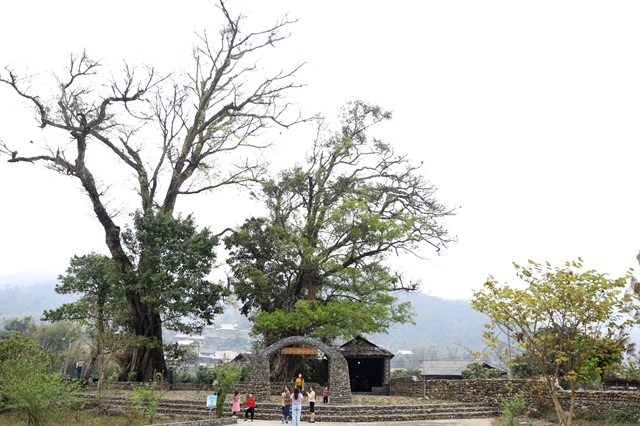 Life & Style
Life & Style

 |
| Ngọc Chiến Commune is home to seven heritage trees of Việt Nam. — VNS Photo Đoàn Tùng |
Lương Hương
Ngọc Chiến Commune in the northern province of Sơn La is blessed with many natural gifts – poetic mountainous landscape, hot mineral water springs and particularly, seven ancient trees that have been recognised as national heritage.
The commune is located about 80km from the centre of Sơn La City and nearly 300km from Hà Nội. Visitors can travel to the locality either through Sơn La City or on Khau Phạ, one of the four longest mountain passes in northern Việt Nam, spanning some 30 kilometres.
The seven ancient trees were listed as Việt Nam’s heritage trees by Vietnam Association for Conservation of Nature and Environment (VACNE). They are an Evelyn keteleeria tree in Nà Tâu Village, a cluster of three banyans in Lướt Village, a red flower kapok tree in Phày Village and two oaks in Mường Chiến Village.
According to local elders, all these trees are associated with legends from the birth of Ngọc Chiến Commune. They stand the test of time and have spiritual values believed to bring good fortune for the locals and favourable weather for their bumper crops.
 |
| The 1,000-year-old Evelyn keteleeria tree in Nà Tâu Village. — VNS Photo Đoàn Tùng |
The first leg of my journey to explore these trees is Nà Tâu, home to the 1,000-year-old Evelyn keteleeria tree, which is regarded by the locals as the Guardian of the village.
There we were told a legend by Tòng Văn Hải who keeps the shrine worshiping the ancient tree.
“When the settlers first arrived here, they intended to cut down the tree to build houses and cultivate the land," Hải said.
"However, a fierce storm suddenly came and the sky turned pitch black. From on top of the tree, a gigantic tiger descended. Its eyes glowed red like burning coals, and it roared menacingly, poised to attack everyone.
“Then, an elderly man emerged from within the tree, saying that this is a divine tree and a sacred dwelling place. If people want stay to live and cultivate, the spirits will protect them. But under no circumstances should the tree be cut down, or the entire village will perish. Then the old man and the tiger vanished.”
From that day, the villagers built a small shrine to worship the deity, and they referred to the tree as a Divine.
Every year, on the 7th day of the first lunar month, before a new crop, Nà Tâu villagers hold a solemn ceremony at the shrine, seeking the blessings of the divine spirits for favourable weather, abundant crops, and the well-being of the community.
Next stop on my exploration of the sacred trees is the three banyans in Lướt Village.
 |
| Three ancient banyans in Lướt Village. — VNS Photo Đoàn Tùng |
According to the village elders, these trees are the remaining from the early reclamation and expansion of the land, and they have become revered in the community.
The banyan trees are estimated to be more than 400 years old, symbolising the deep connection between the people and the land.
My next destination was Mường Chiến Village where two oak trees stand side by side amid the flower fields.
 |
| Two oak trees in Mường Chiến Village. — VNS Photo Đoàn Tùng |
According to the legend of the white Thái ethnics, these sacred trees have been present since the establishment of Mường Chiến Village. Villagers often visit the trees to pray for happiness, especially couples.
“These two trees are considered symbols of loyal and enduring relationships, representing strong and unbreakable bonds,” said Cầm Văn Hội, an elderly villager.
The last heritage tree is the 300-year-old red-flowered kapok tree, located at the centre of Phày Village. It was planted by locals when the village was established.
 |
| The 300-year-old kapok tree in Phày Village. — VNS Photo Đoàn Tùng |
Unlike heritage trees in other localities, each one in Ngọc Chiến has a shrine nearby and is taken care of by a villager.
Ethnic Thái people believe that ancient trees that have survived for hundreds of years are abodes of divine spirits or sanctuaries for the souls of the departed. It is highly respected and strictly forbidden to harm or cut down these ancient trees, as it is believed to bring about unfortunate events.
QR codes have been provided on the spot so that visitors could check-in and gain a deeper understanding of the legends and significance behind these majestic trees.
Trần Ngọc Hải, vice chairman of the Heritage Tree Council under the VACNE, said the heritage trees in Ngọc Chiến Commune are highly valuable in terms of genetic resources, ecological environment, and the cultural heritage of the area.
“What sets Ngọc Chiến apart is that many generations from the same family have been involved in protecting these sacred trees in this region. In particular, the Evelyn keteleeria tree has had four generations actively preserving it,” he said.
According to Bùi Tiến Sỹ, secretary of the Communist Party Committee of Ngọc Chiến Commune, the heritage trees create a tourist attraction of the locality, thanks to not only the beautiful landscape, unique nature, and culture but also the mysterious stories associated with them.
Phạm Mai Linh, a visitor from Hà Nội, said she was interested in the visit to the heritage trees and the legends about them.
"They are ideal tourist destinations that combine natural beauty with the distinctive cultural features of the local ethnic groups." — VNS




